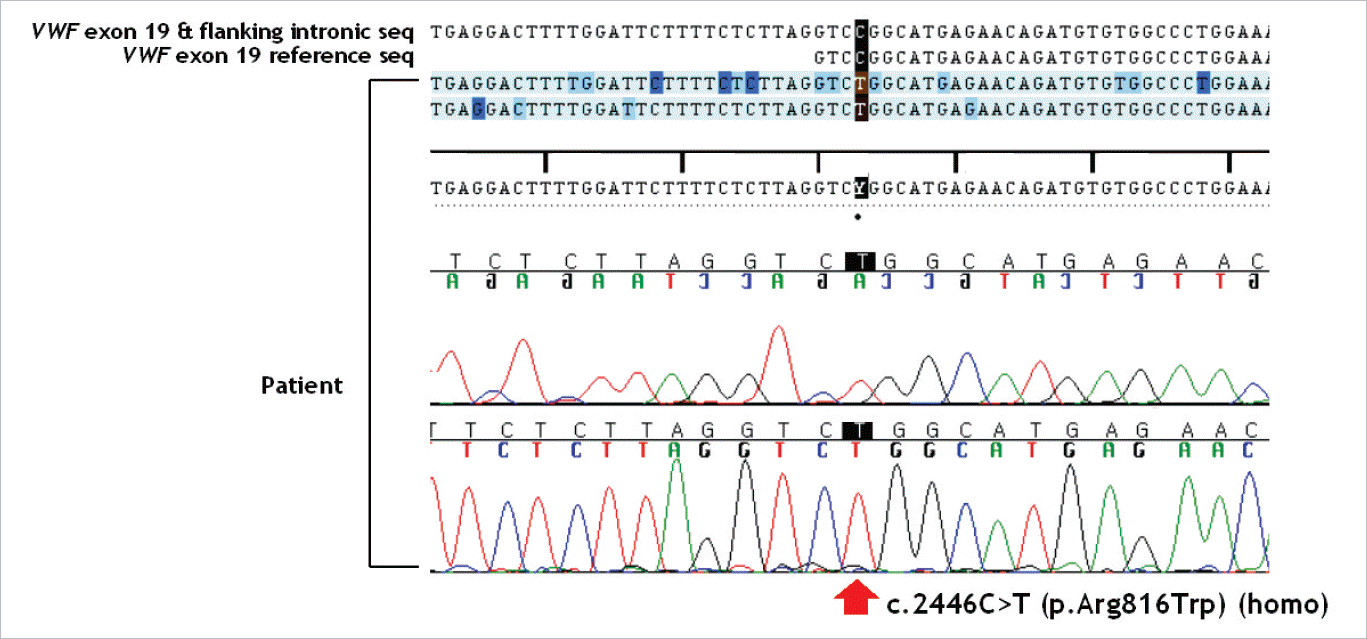Abstract
Type 2N von Willebrand disease (vWD) can be confused with hemophilia A due to decreased factor VIII levels and a bleeding tendency, and differential diagnosis is of importance for providing the optimal treatment and genetic counseling. For the accurate diagnosis of type 2N vWD, von Wille-brand Factor (vWF) function tests, multimer assay and gene mutation analysis are needed. The patient was a 38-yr-old Nepalese woman with a history of bleeding manifestations from childhood, such as hemarthrosis, intramuscular hematoma, and menorrhagia. Family history revealed that her mother and elder brothers also had bleeding manifestations from childhood. When she had a laparotomy in 1991, she was diagnosed as hemophilia A with factor VIII level of 3.6% and was transfused with whole blood, factor VIII and cryoprecipitates. In June 2007, she was admitted to our hospital for further evaluation of bleeding tendency. Blood tests revealed normal CBC; bleeding time, 2 min; PT, 14.9 sec (11-14 sec); aPTT, 51.2 sec (24-38 sec); and factor VIII, 4.9% (50-150%). The prolonged aPTT was corrected by 1:1 mixing test to the levels of 106% and 84%, respectively, before and after 2 hr-incubation at 37°C. No abnormalities were found in the vWF antigen level (71.3%), ristocetin cofactor assay (130.4%), and multimer assay. Direct DNA sequencing of the VWF gene revealed homozygous missense mutation located in exon 19, c.2446C>T (p. Arg816Trp), confirming the diagnosis of type 2N vWD.
REFERENCES
1.Greer JP, Rodgers GM, editors. Wintrobe's clinical hematology. 11th ed. Philadelphia: Lippincott Williams and Wilkins;2004. p. 1628–37.
2.Michiels JJ., Berneman Z., Gadisseur A., van der Planken M., Schroyens W., van de Velde A, et al. Classification and characterization of hereditary types 2A, 2B, 2C, 2D, 2E, 2M, 2N and 2U (unclassifiable) von Willebrand disease. Clin Appl Thromb Hemost. 2006. 12:397–420.

3.Song J., Choi JR., Song KS. Investigation of von Willebrand factor gene mutations in Korean von Willebrand disease patients. Korean J Lab Med. 2007. 27:169–76. (송재우, 최종락, 송경순. 한국 von Willebrand 병 환자의 von Willebrand 인자 유전자 돌연변이 조사.대한진단검사의학회지 2007;27: 169-76.).

4.Kang SH., Kim EJ. Subtypes of von Willebrand disease based on vWF multimer analysis in Korea. Korean J Pediatr Hematol-Oncol. 2000. 7:42–9. (강신혜및김은주. vWF multimer assay로확진된von Willebrand disease 의아형분류. 대한소아혈액종양학회지 2000;7: 42-9.).
5.Schneppenheim R., Budde U., Krey S., Drewke E., Bergmann F., Lechler E, et al. Results of a screening for von Willebrand disease type 2N in patients with suspected haemophilia A or von Willebrand disease type 1. Thromb Haemost. 1996. 76:598–602.

6.Nesbitt IM., Goodeve AC., Guilliatt AM., Makris M., Preston FE., Peake IR. Characterisation of type 2N von Willebrand disease using phenotypic and molecular techniques. Thromb Haemost. 1996. 75:959–64.

7.Miller CH., Kelley L., Green D. Diagnosis of von Willebrand disease type 2N: a simplified method for measurement of factor VIII binding to von Willebrand factor. Am J Hematol. 1998. 58:311–8.

8.Mazurier C., Meyer D. Factor VIII binding assay of von Willebrand factor and the diagnosis of type 2N von Willebrand disease–results of an international survey. On behalf of the Subcommittee on von Willebrand Factor of the Scientific and Standardization Committee of the ISTH. Thromb Haemost. 1996. 76:270–4.
9.Caron C., Mazurier C., Goudemand J. Large experience with a factor VIII binding assay of plasma von Willebrand factor using commercial reagents. Br J Haematol. 2002. 117:716–8.

10.Mazurier C., Goudemand J., Hilbert L., Caron C., Fressinaud E., Meyer D. Type 2N von Willebrand disease: clinical manifestations, pathophysiology, laboratory diagnosis and molecular biology. Best Pract Res Clin Haematol. 2001. 14:337–47.

11.Simon D., Roisenberg I. Type 2N von Willebrand disease mutations in Brazilian individuals. Haemophilia. 2004. 10:473–6.

12.Gupta M., Bhattacharyya M., Choudhry VP., Saxena R. Spectrum of inherited bleeding disorders in Indians. Clin Appl Thromb Hemost. 2005. 11:325–30.

13.Gupta PK., Charan VD., Saxena R. Spectrum of Von Willebrand disease and inherited platelet function disorders amongst Indian bleeders. Ann Hematol. 2007. 86:403–7.

14.Gupta PK., Ahmed RP., Sazawal S., Choudhry VP., Saxena R. Relatively high frequency of VWD types 3 and 2 in a cohort of Indian patients: the role of multimeric analysis. J Thromb Haemost. 2005. 3:1321–2.

15.Pasi KJ. Von Willebrand's disease – awareness influences diagnosis. Indian J Med Res. 2005. 121:628–30.




 PDF
PDF ePub
ePub Citation
Citation Print
Print



 XML Download
XML Download